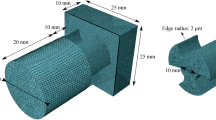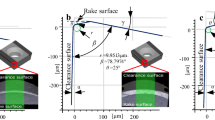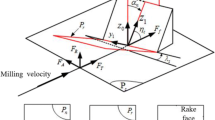Abstract
An attempt was made in the present study to apply damage mechanics to investigate the polycrystalline cubic boron nitride (PCBN) tool failure mechanisms in face milling of hardened steel. Experimental phenomenon relating to damage accumulation was found by means of analyzing the tool wear evolution and macroscale failure of the cutting tool. Damage equivalent stress was used as an indicator to reveal the tool failure mechanisms under different cutting conditions. Because of the larger value of damage equivalent stress, there was greater likelihood of tool fracture in down milling than that in up milling. Deflection of the shear angle changed the tool stress component and distribution substantially in up milling, leading to the emergence of the peak value of damage equivalent stress in spite of lower values of cutting force and tool temperature. Calculated damage equivalent stress and tool lives obtained in milling tests were compared and analyzed. It was found that damage equivalent stress can be used as an effective tool to analyze the tool failure mechanisms and assess the optimum cutting condition.
Similar content being viewed by others
References
Trent EM, Wright PK (2000) Metal cutting, 4th edn. Butterworth-Heinemann, Woburn
Huang Y, Liang SY (2004) Modeling of CBN tool flank wear progression in finish hard turning. J Manuf Sci Eng Trans ASME 126(1):98–106
Chou YK, Evans CJ, Barash MM (2002) Experimental investigation on CBN turning of hardened AISI 52100 steel. J Mater Process Technol 124:274–283
Arsecularatne JA, Zhang LC, Montross C, Mathew P (2006) On machining of hardened AISI D2 steel with PCBN tools. J Mater Process Technol 171:244–252
Huang Y, Liang SY (2004) Modelling of CBN tool crater wear in finish hard turning. Int J Adv Manuf Technol 24(9–10):632–639
Barry J, Byrne G (2001) Cutting tool wear in the machining of hardened steels: part II: cubic boron nitride cutting tool wear. Wear 247:152–160
Özel T, Hsu TK, Zeren E (2005) Effects of cutting edge geometry, workpiece hardness, feed rate and cutting speed on surface roughness and forces in finish turning of hardened AISI H13 steel. Int J Adv Manuf Technol 25:262–269
El-Wardany TI, Kishawy HA, Elbestawi MA (2000) Surface integrity of die material in high speed hard machining, part 1: micrographical analysis. J Manuf Sci Eng Trans ASME 122:620–631
Iqbal A, He N, Li L, Dar NU (2007) A fuzzy expert system for optimizing parameters and predicting performance measures in hardmilling process. Expert Syst Appl 32(4):1020–1027
Liu ZQ, Ai X, Zhang H, Wang ZT, Wan Y (2002) Wear patterns and mechanisms of cutting tools in high-speed face milling. J Mater Process Technol 129(1–3):222–226
Cui X, Zhao J, Dong Y (2013) The effects of cutting parameters on tool life and wear mechanisms of CBN tool in high-speed face milling of hardened steel. Int J Adv Manuf Technol 66(5–8):955–964
Krajcinovic D (2000) Damage mechanics: accomplishments, trends and needs. Int J Solids Struct 37:267–277
Uhlmann E, Von Der Schulenburg MG, Zettier R (2007) Finite element modeling and cutting simulation of Inconel 718. CIRP Ann Manuf Technol 56(1):61–64
Mabrouki T, Girardin F, Asad M, Rigal JF (2008) Numerical and experimental study of dry cutting for an aeronautic aluminium alloy (A2024-T351). Int J Mach Tools Manuf 48(11):1187–1197
Vaz M Jr, Owen DRJ, Kalhori V, Lundblad M, Lindgren LE (2007) Modelling and simulation of machining processes. Arch Comput Methods Eng 14(2):173–204
Lemaitre J, Desmorat R (2005) Engineering damage mechanics: ductile, creep, fatigue and brittle failures. Springer, Berlin
Yang WH, Tarng TS (1998) Design optimization of cutting parameters for turning operations based on the Taguchi method. J Mater Process Technol 84:122–129
Chen L, El-Wardany TI, Nasr M, Elbestawi MA (2006) Effects of edge preparation and feed when hard turning a hot work die steel with polycrystalline cubic boron nitride tools. CIRP Ann Manuf Technol 55(1):89–92
Cui X, Zhao J, Zhou Y, Zheng G (2013) Damage mechanics analysis of failure mechanisms for ceramic cutting tools in intermittent turning. Eur J Mech A Solids 37:139–149
Lemaitre J, Lippmann H (1992) A course on damage mechanics. Springer, Berlin
Author information
Authors and Affiliations
Corresponding author
Rights and permissions
About this article
Cite this article
Cui, X., Guo, J., Zhao, J. et al. Analysis of PCBN tool failure mechanisms in face milling of hardened steel using damage equivalent stress. Int J Adv Manuf Technol 80, 1985–1994 (2015). https://doi.org/10.1007/s00170-015-7175-2
Received:
Accepted:
Published:
Issue Date:
DOI: https://doi.org/10.1007/s00170-015-7175-2




